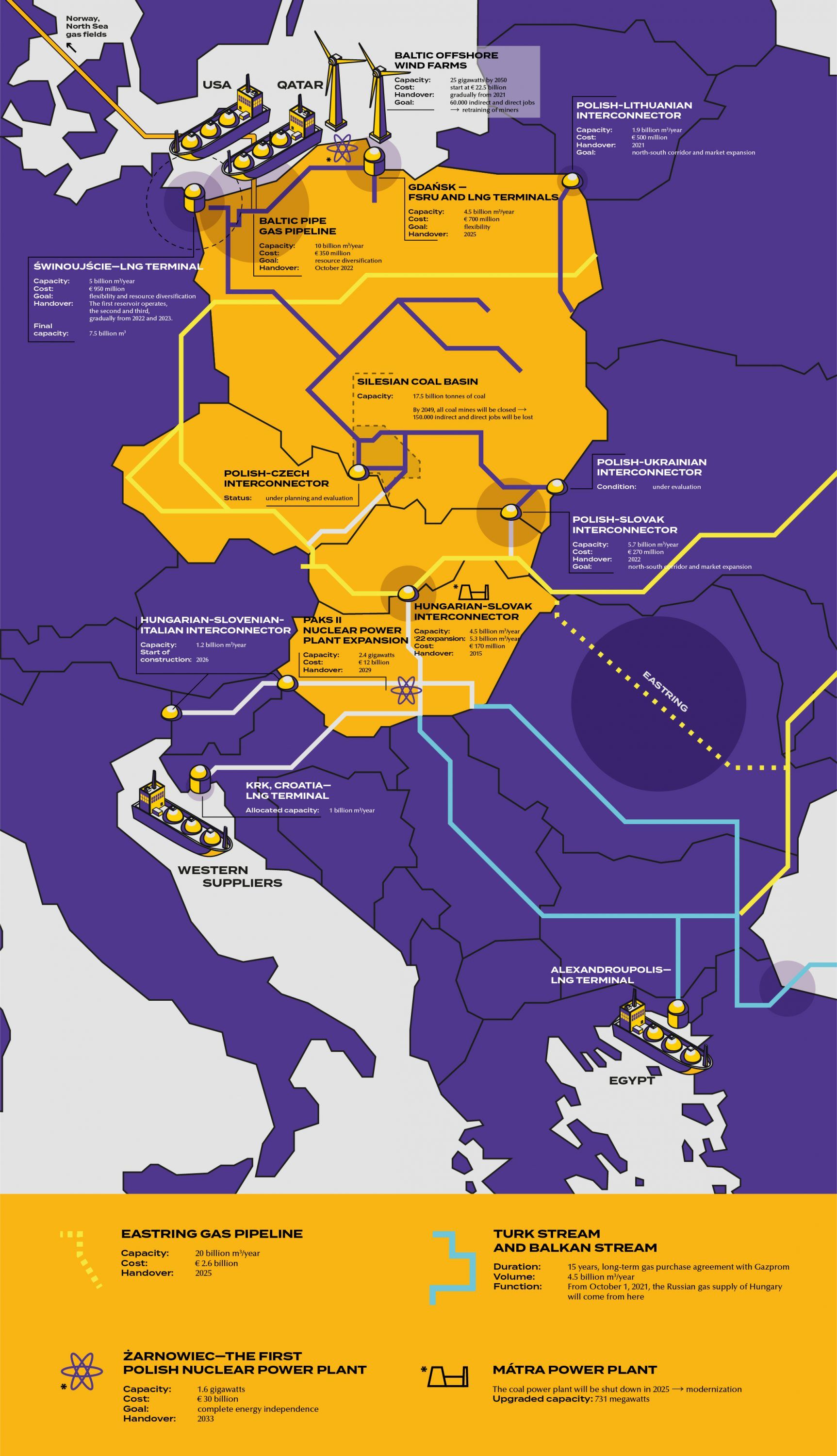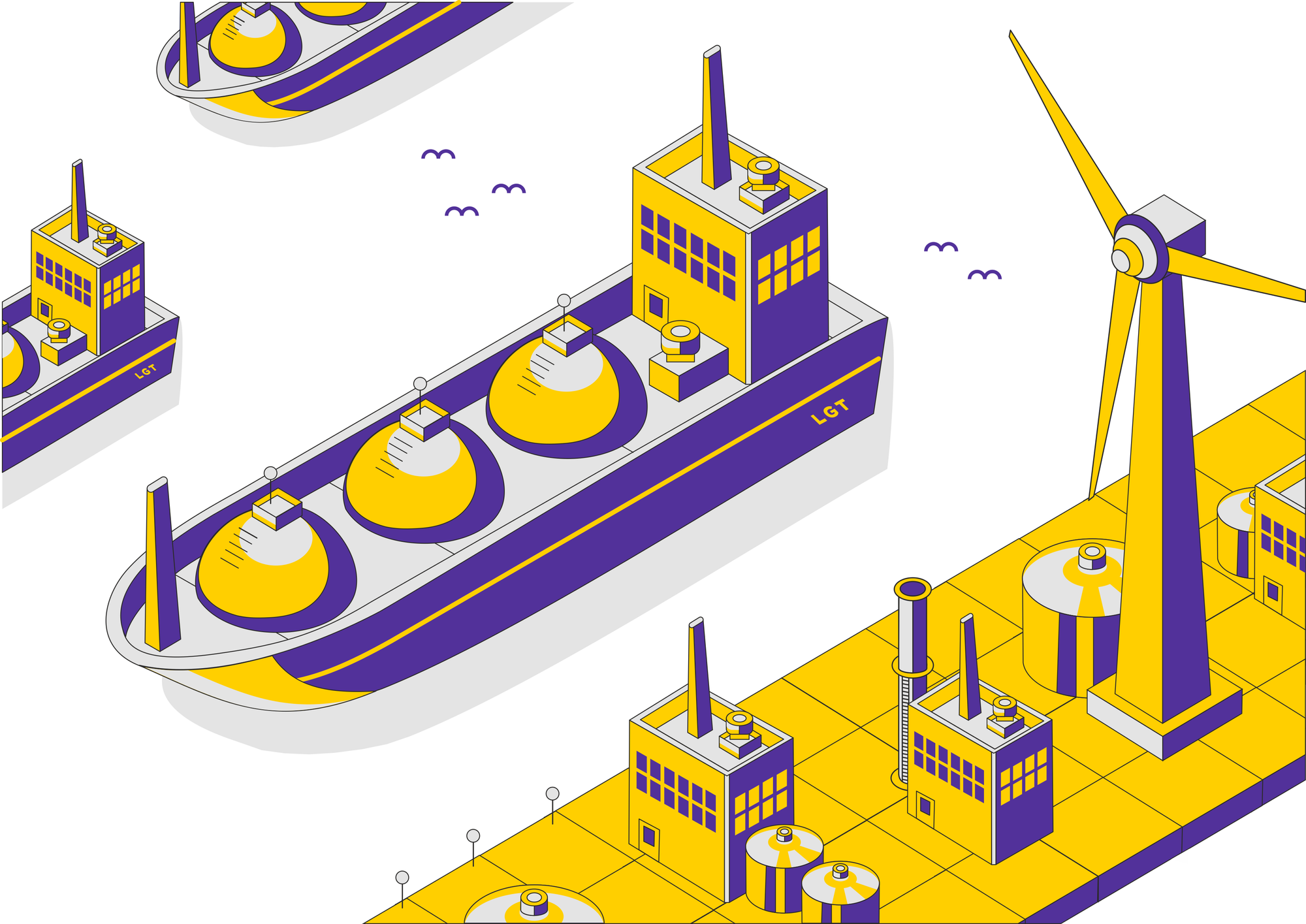Central European gas games, regional integration and freezing winter. Poland is becoming independent of Russian gas, building a north-south corridor and managing a complete energy transition. Hungary is signing a long-term contract with Gazprom, while also looking to other sources. Analysis of the region’s energy and gas strategy—Part I
Europe is in panic, gas prices are skyrocketing, Gazprom throws up his hands, people are afraid of rising utility prices, while the Western concept of flexible, market-based gas procurement has failed. From the perspective of Warsaw and Budapest, the picture is quite surreal, because the Central and Eastern European region is on a different path in terms of energy and gas policy. Poland is becoming independent of Russian gas, is building a north-south corridor and is managing a complete energy transformation. Hungary has a long-term contract with Gazprom, but is also looking to other sources. And the region could become part of an integrated energy system that not only breaks the Russian gas monopoly but could bring about a radical energy transformation.
So far away from me and yet so close—Warsaw and Moscow
Source diversification is a key principle for Poland’s energy sector, and especially for the gas sector, as Warsaw believes that the monopoly of Russia’s Gazprom has dominated the European market for too long. Of course, there is also a security policy consideration behind the Polish position, as Polish—Russian relations are far from friendly and Poland feels still hunted by the spectre of the Russian threat, whether justified or not. Hence the main objective of energy policy is to become independent of Moscow at any cost.
Gaining independence, however, is far from easy, as the Polish energy mix has undergone a drastic transformation in recent years and the biggest challenges are still to come. Nearly 40 percent of Poland’s energy production is currently coal-based, but coal mines are to be completely closed by 2049 at the latest. The next step in the transformation of coal energy is gas, as coal-fired power plants can be converted into gas-fired power plants, just as gas reserves in the coal basin can be used to generate energy. Thus, the demand for gas in the country is growing year by year. The energy transition is not only affecting mines, but also boilers in family homes since coal-fired domestic heating is still very popular in Poland. It is estimated that the current annual consumption of about 20 billion m3 could reach 30 billion m3 by 2030, which would be a huge challenge for Polish energy policy and infrastructure: to manage a transformation with a continuous increase in demand while becoming independent from the Russian gas market and balancing the supply side. It is a big challenge, and the Poles are basically applying three parallel solutions in the gas market.
Short energy dictionary
LNG: liquefied natural gas. It has almost the same composition as natural gas in the traditional sense but in a cooled form. This means that it has a temperature of -162°C and a lower density than water.
FSRU: floating storage and regasification unit, an almost mandatory component of LNG terminals, usually a special vessel or floating unit between the LNG carrier and the onshore LNG terminal.
Interconnector: cross-border gas pipeline.

LNG, politics and the Polish legacy of Chernobyl
The first pillar of Poland’s new energy and gas strategy is the świnoujście LNG terminal, which with a capacity of 7.5 billion m3/year can cover roughly 35 percent of current gas consumption from LNG sources. LNG is not only one of the most advanced technologies, but is also flexible, providing an adequate response to possible changes in the global market. Today, Poland’s main suppliers are the United States and Qatar. And LNG suppliers are in fierce competition with the classical gas companies, so the price is often cheaper or the same as if the gas was purchased from a classical source. The świnoujście LNG terminal is currently under expansion and is one of the most expensive energy projects in Poland, costing €950 million. However, the świnoujście LNG terminal would not be able to meet the growing demand, so another FSRU and LNG terminal with a capacity of 4.5 billion m3/year will be built in Gdańsk, the country’s largest port, by 2025, which, together with its sister terminal in świnoujście, will give the flexibility to meet gas demand.
The second pillar of Warsaw’s energy and gas strategy is the so-called Baltic Pipe gas pipeline, which will connect the Norwegian gas fields in the North Sea to Poland via Denmark. The €350 million project could deliver 10 billion m3 of gas per year to the Polish market and will link the Western and Central European markets. Once the Polish LNG terminals and the Baltic Pipe are fully operational, the Polish energy sector will be almost completely independent from Russian suppliers.
And the third pillar of the Polish policy is the implementation of the North-South energy and gas corridor. Warsaw’s energy investments aim to disrupt the East-West relationship that defines Europe and create a unique corridor, both in terms of efficiency and flexibility that will redefine the energy and gas markets of Central and Eastern Europe with a North-South axis. The idea of the project is commercially sound, but there is a more important dimension: politics. Politically, Poland has a lot to gain from the implementation of the North-South corridor, as it is the leading economy and the largest country in the region and the interconnection of North-South infrastructure will strengthen Warsaw’s Three Seas Initiative concept. And in this case, it is not surprising that the Polish energy and gas policy is building capacity not only to meet domestic demand but also for export activities. The Polish-Slovak interconnector is due to be completed in 2022 with an annual capacity of 5.7 billion m3, while the Hungarian-Slovak interconnector has been operational since 2015 and is currently being expanded. And through the Hungarian market, Poland also has access to the Serbian or Romanian markets as well.

Poland is helping to reduce the Baltic’s dependence on Russian gas, as the Polish-Lithuanian interconnector, which came on stream this year, is primarily aimed at ensuring energy security in the Baltic countries, extending the North-South gas corridor and gaining a new market share for Poland. Warsaw’s plans are even more ambitious, with the Polish-Czech interconnector already on the table and the Polish-Ukrainian interconnector in the evaluation phase, which is likely to be realized in a few years, as the Ukrainian market offers huge potential in the current security policy environment.
The gradual integration of the region’s gas network will create a complex system that will make the whole intermarium region an integral entity in the gas market, which will not only lead to infrastructural diversification, but also to a transformation on the source-side. Warsaw is determined to make the region independent not only from Russian but also from German influence, as the Nord Stream pipeline could provide Germany with enough competitive advantage to dominate the markets of Central and Eastern Europe. As a senior Polish government source summed up the situation for us with regard to Nord Stream 2: “The whole region is affected by the joint project of Germany and Russia, given that the primary target market for gas from the pipeline is the Central and Southern European region, and German industry has enough capacity from Nord Stream 1; this manoeuvre not only increases Gazprom’s market advantage in Europe but also allows Germany to dominate the market, which is anything but open competition.”
Polish energy developments beyond the gas market are also a topic worth mentioning. Poland does not currently have a nuclear power plant, although the communist leadership had already started construction of a nuclear facility in Żarnowiec in 1982, but work was halted by the 1986 Chernobyl disaster and the resulting change in the economic and political situation. What was frozen by the communist Polish leadership has been reheated by the current right-wing government, which plans to put the first unit in Żarnowiec into operation by 2033. The planned power plant would have a capacity of 1.6 gigawatts, which could cover roughly 25 percent of the country’s energy consumption, at a total cost of a gigantic €30 billion. Another major shift in Poland’s energy mix could come with the adoption this year of a wind power law that would build 25 gigawatts of wind power capacity in the Baltic Sea by 2050, creating the largest offshore wind farm in the region. The investments would create 60,000 direct and indirect jobs, filled by staff from closed mines and service infrastructure.
Overall, it can be said that the current Polish energy policy is following a unique path, promoting regional integration and cementing Warsaw’s leading role in the Central and Eastern European region. However, Budapest, too, is keeping up with the fast Polish pace.

The situation in Hungary will be discussed in the second part of our series of articles to be published next week.

You can have a comfy sleep anywhere with Renault's new concept car

Animated short film about the legendary boxer Laci Papp wins award










